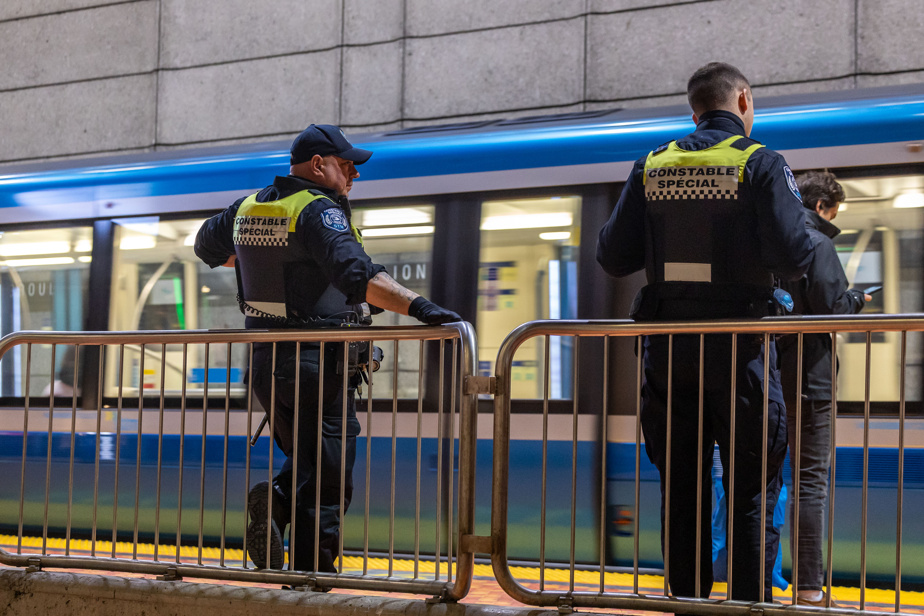“It’s made like Harlem, New York. » The day after two violent events that occurred at the Lionel-Groulx metro station – a homeless man beaten and stabbed by a group of young people and a young woman hit in the face – users expressed a growing feeling of insecurity.
“Sometimes, in the evening, it becomes aggressive. It’s a different beast,” said Mark Landry, met while begging on the station platform on Friday evening.
Showing a scar on his shoulder, the man says he was the victim of young thieves, between 17 and 25 years old, who allegedly attacked him with a sharp object to steal his violin, about two weeks ago .
Employee of a jewelry stand installed on a mezzanine of the station, Ijaz Ahmad also notes that more and more thieves are rampant in Lionel-Groulx, particularly over the past two years. “Sometimes they are children, or homeless people,” he says through the hubbub of users jumping from one metro line to another.

PHOTO JOSIE DESMARAIS, THE PRESS
Five young people, including four minors, were arrested after the attack Thursday evening on a homeless person in the entrance to the Lionel-Groulx station.
For many, who are just passing through, getting off at Lionel-Groulx station is no more dangerous than before, but for these two regulars, the observation is clear: the place is no longer safe, especially in the evening. “It’s like Harlem, New York,” says Mark Landry.
Homeless man stabbed
Friday, the Montreal City Police Service (SPVM) arrested five young people, including four minors, suspected of having beaten and stabbed a homeless man in the station entrance the day before.
The suspects, aged 13, 15 and 17, appeared in youth court on Friday. Their alleged 18-year-old accomplice should be charged at a later date.
Some of the young people arrested were already known to the police.

PHOTO JOSIE DESMARAIS, THE PRESS
Lionel-Groulx station, in the South-West
The investigation is still ongoing and another suspect remains sought by the SPVM. The attack by the group of young people could be linked to drug trafficking.
The victim was stabbed around 8:30 p.m. The 35-year-old man apparently regained consciousness when the police arrived and his injuries were not life-threatening. According to our information, he is a known homeless person in the area.
A second attack
Another violent episode occurred a few hours later at the same metro station. The daughter of columnist Nathalie Collard and host and columnist Richard Martineau received a punch in the face while she was waiting for the metro, shortly before midnight. An agitated woman, getting out of a metro car, hit the young woman who was on the platform.
A lady approached to help the shaken young woman, who did not suffer serious injuries.
No question of ostracizing the homeless. No one blames homeless people. We want the metro to remain safe.
Nathalie Collard, columnist at The Press
Her 24-year-old daughter only travels every day by metro, said Nathalie Collard. “This type of event perhaps happens to many other citizens every month,” she added, highlighting the growing feeling of insecurity for users like her and her daughter.
Read Nathalie Collard’s column “Taking the metro has become stressful (repeat)”
There was no security agent around at the time of the incident nor any police presence, described the victim’s mother.
Many staff
However, the picture was completely different the day after these events, as was observed The Press. At least three police officers from the SPVM Metro Section were there Friday evening, in addition to special constables and two “security ambassadors”, new personnel added this year by the Société de transport de Montréal (STM).

PHOTO JOSIE DESMARAIS, THE PRESS
A “security ambassador”, among others, was present near the turnstiles when The Press Friday.
For some users, this presence is not reassuring, especially in the evening. “I try to be there as little as possible during these hours,” said one of them, Florence.
“The attacks that occurred [jeudi] at Lionel-Groulx station are unacceptable. The SPVM quickly took charge of the situation and an investigation is underway,” reacted Alain Vaillancourt, responsible for public security on the executive committee of the City of Montreal.
He recalled the implementation of the new intervention model in the transport network, which involves the addition of resources to respond to calls in the metro. “The collaboration between the police forces, the STM special constables and our EMMIS team agents [Équipe mobile de médiation et d’intervention sociale] is also at the center of this new approach. »
The solution also involves more mental health and addiction support with the involvement of community and institutional partners, he added.
